As the electric vehicle revolution accelerates, two names stand at the pinnacle of electric vehicle performance in 2025 — Rimac Nevera and Lucid Air Sapphire. These two electric powerhouses are not just fast; they’re redefining what speed, luxury, and innovation mean in the EV world.
In a time when the fastest electric cars of 2025 are challenging traditional supercars, both the Rimac Nevera and Lucid Air Sapphire represent the ultimate blend of advanced engineering and futuristic design. But how do they compare when it comes to real-world performance, acceleration, handling, and everyday usability?
This detailed comparison will dive into everything from Rimac Nevera’s top speed to Lucid Air Sapphire’s performance metrics — helping you understand which of these two electric titans truly leads the EV arms race.
1. Brand Philosophy & Design Intent
Rimac Nevera
Developed by Croatian automaker Rimac Automobili, the Nevera is a pure electric hypercar engineered from the ground up for sheer performance. It’s a limited-production model designed to showcase the future of electric propulsion — offering mind-bending acceleration and top-tier technology. Every element, from its carbon monocoque chassis to its torque-vectoring all-wheel drive, is aimed at delivering maximum speed and control.
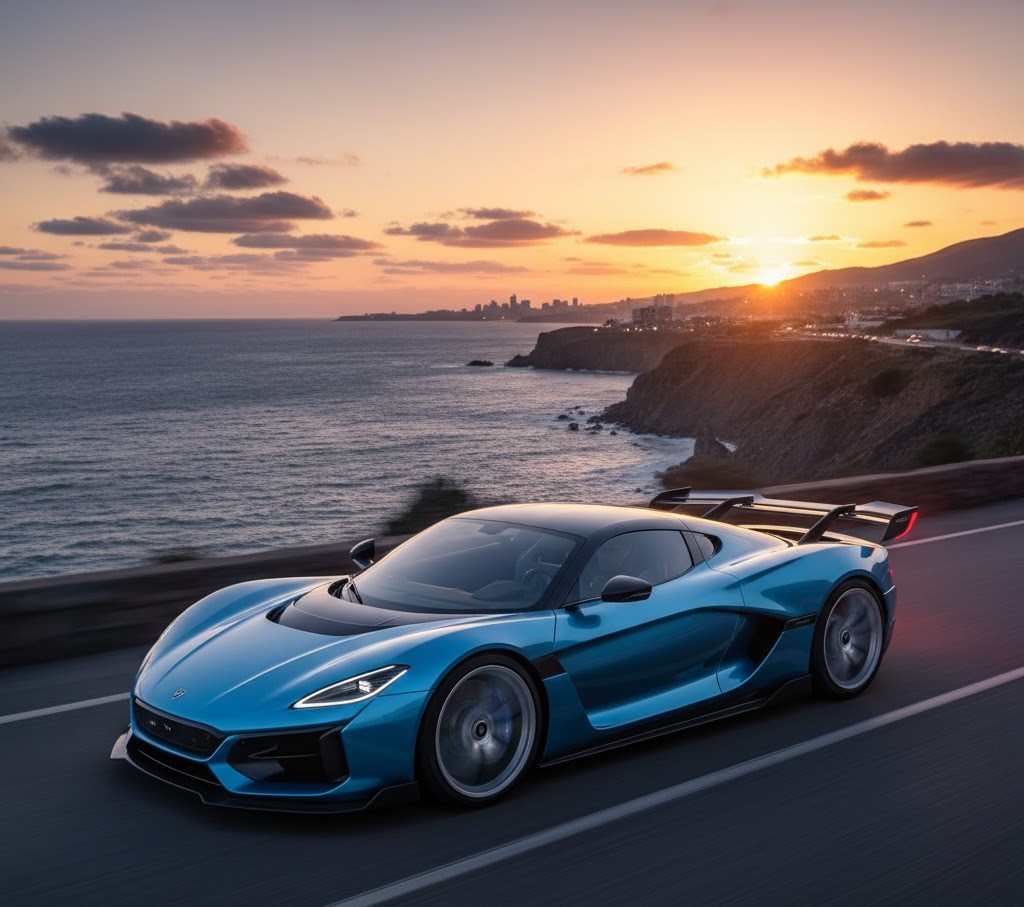
Lucid Air Sapphire
Lucid Motors, a California-based EV manufacturer, entered the luxury performance segment with the Lucid Air Sapphire, a more road-friendly alternative to hypercars like the Nevera. While it’s not a limited-production exotic, the Sapphire was crafted to push boundaries in a luxury sedan format. It’s a performance beast built on practicality, luxury, and cutting-edge EV tech — positioned as a direct competitor to Tesla’s Model S Plaid+.
2. Powertrain and Acceleration
Rimac Nevera
- Power Output: 1,914 horsepower
- Torque: 2,360 Nm
- 0–60 mph: 1.85 seconds
- Drivetrain: Quad-motor all-wheel drive
With nearly 2,000 horsepower, the Nevera is currently one of the fastest electric cars of 2025, delivering neck-snapping acceleration that surpasses most internal combustion supercars. This monster EV features four independent electric motors—one for each wheel—offering unmatched torque vectoring for stability and agility at high speeds.
Lucid Air Sapphire
- Power Output: 1,234 horsepower (estimated)
- Torque: Over 1,430 Nm (estimated)
- 0–60 mph: 1.89 seconds
- Drivetrain: Tri-motor all-wheel drive
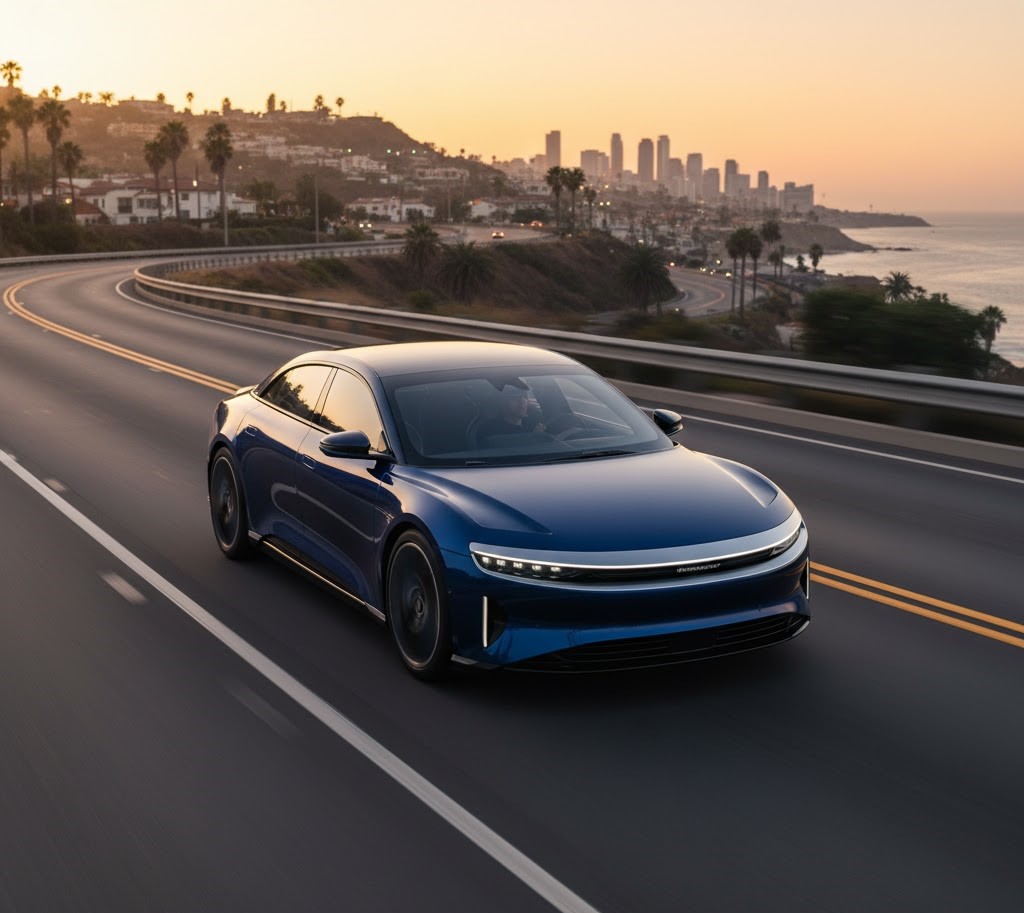
While the Lucid Air Sapphire has lower horsepower compared to the Nevera, its performance numbers are incredibly close, especially considering it’s a four-door luxury sedan. This tri-motor system offers exceptional straight-line performance and precise handling, making the Lucid Air Sapphire performance nothing short of astonishing.
3. Top Speed Comparison
Rimac Nevera Top Speed
- Top Speed: 258 mph (415 km/h)
This figure is a world-record territory for electric cars. The Rimac Nevera’s top speed solidifies it as a hypercar designed not just for acceleration, but for sustained high-speed cruising, thanks to its advanced cooling and aerodynamic systems.
Lucid Air Sapphire Top Speed
- Top Speed: 205 mph (estimated)
Though significantly slower than the Nevera in this regard, 205 mph is still blisteringly fast for a sedan. Lucid has clearly prioritized stability and usability at high speeds, especially for public roads.
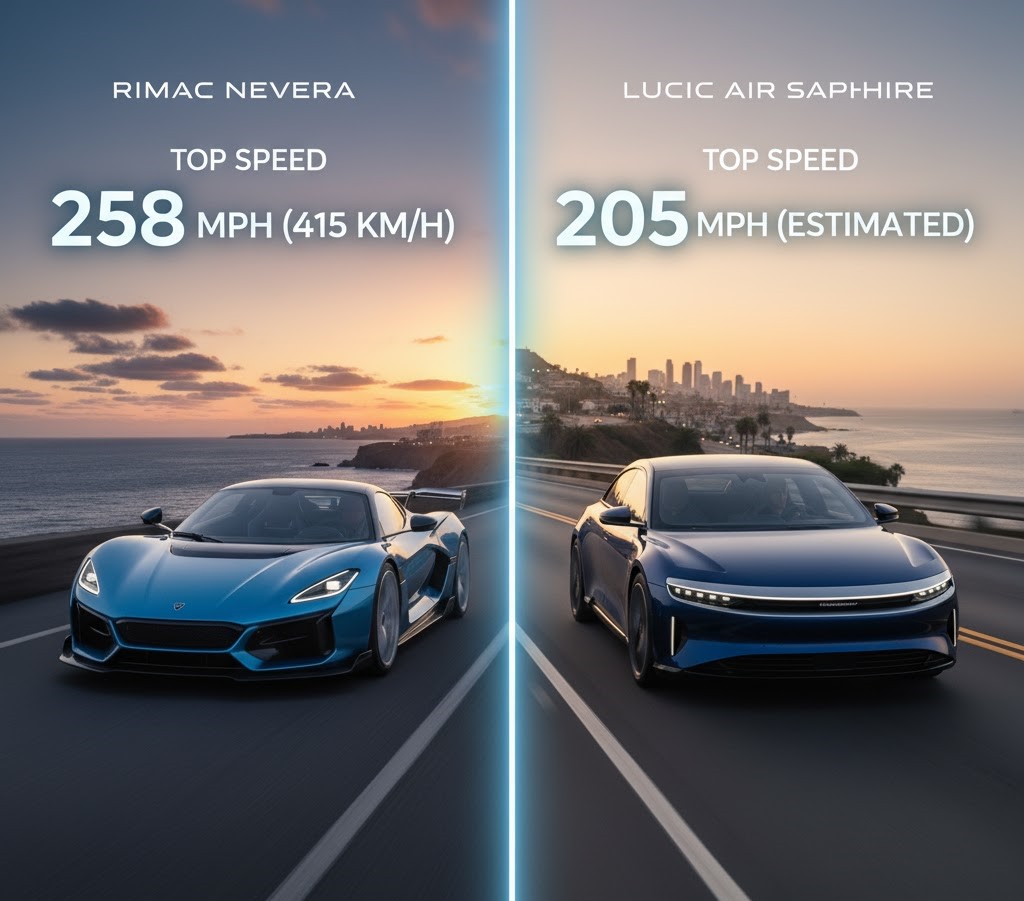
4. Handling and Driving Experience
Rimac Nevera
The Nevera’s unique all-wheel torque vectoring system constantly adjusts torque to each wheel for optimal traction. Paired with active aerodynamics and carbon-ceramic brakes, this EV handles more like a track-focused race car than a road-legal vehicle.
While it offers driving modes for street use, it thrives on a racetrack, where precision and speed are fully unleashed.

Lucid Air Sapphire
The Air Sapphire aims to deliver the best of both worlds: track-ready dynamics and luxury sedan comfort. Its dual rear motors enable torque vectoring, improving cornering and responsiveness. Unlike the Nevera, the Lucid is designed to handle both spirited driving and long-distance cruising in luxury.
For drivers who want everyday usability without sacrificing thrills, the Sapphire hits a sweet spot.
5. Interior & Practicality
Rimac Nevera
The interior of the Nevera is purpose-built — sporty, minimalistic, and focused on the driving experience. While it includes digital interfaces and carbon-fiber trim, it lacks the spaciousness and infotainment comforts of mainstream EVs.
Storage is minimal, and its low ride height makes it less than ideal for daily driving. It’s a weekend warrior or collector’s showpiece — not a grocery-getter.
Lucid Air Sapphire
Here’s where the Lucid Air Sapphire shines. It features a luxurious cabin with leather, suede, and high-tech displays. There’s plenty of legroom, cargo space, and even advanced driver-assist features — unheard of in traditional performance vehicles.
This car proves that you can have world-class acceleration and daily driving comfort, making it one of the best electric cars of 2025 for real-world use.
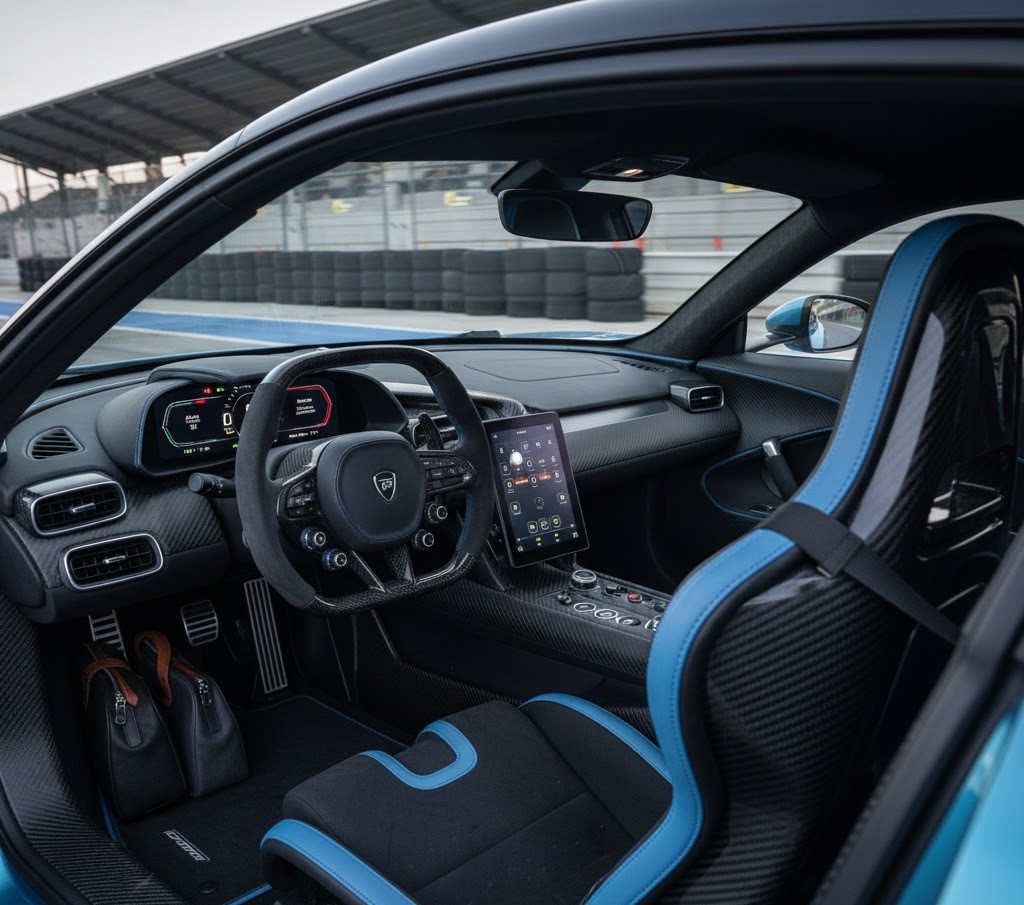
6. Price & Availability
Rimac Nevera
- Price: $2.2 million (approx.)
- Production: Limited to 150 units globally
It’s a hyper-exclusive vehicle for collectors and performance purists. With only 150 units produced, the Nevera isn’t just a car — it’s a status symbol and engineering showcase.
Lucid Air Sapphire
- Price: $249,000 (approx.)
- Production: Limited but more widely available than the Nevera
Though not cheap, the Sapphire is significantly more accessible. It offers a compelling balance between performance and luxury, especially for those who want a taste of hypercar performance in a usable format.
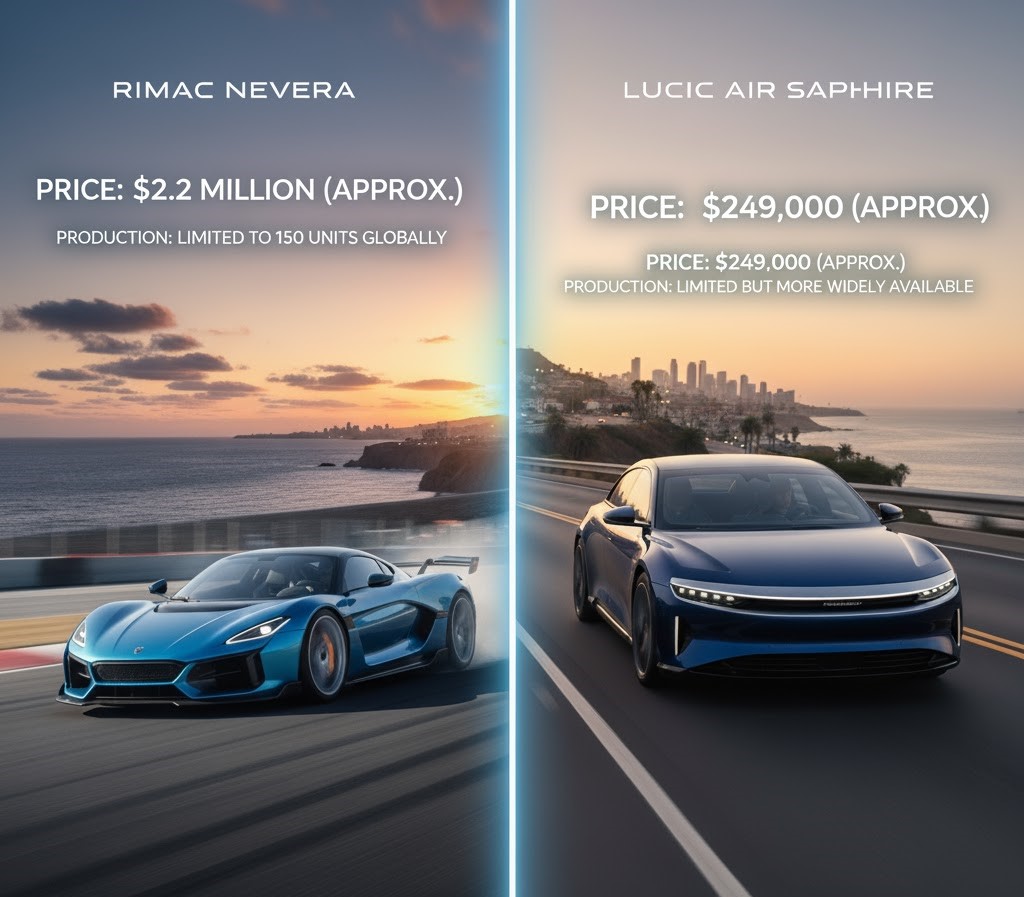
Conclusion
Choosing between the Rimac Nevera and Lucid Air Sapphire comes down to what you prioritize in a vehicle.
- If you’re looking for the absolute fastest electric car in 2025, the Rimac Nevera’s top speed and engineering dominance make it the clear winner. It’s built for thrill-seekers who want nothing but the best in speed and technology, regardless of price or practicality.
- On the other hand, if you want exhilarating speed with real-world usability, the Lucid Air Sapphire’s performance is nothing short of revolutionary. It blends luxury, innovation, and daily drivability in a way few cars—electric or not—can match.
Both vehicles showcase how far EVs have come and where they’re heading. From hypercars to luxury sedans, the future is electric, and the possibilities are endless.
At Nexgenwheels, we believe these vehicles represent not just the future of performance, but the future of driving itself. Whether you’re a speed enthusiast, a luxury lover, or a tech aficionado, 2025 marks a pivotal moment where electric vehicles are not only competing with — but surpassing — their gas-powered counterparts.
Q: Which is faster — Rimac Nevera or Lucid Air Sapphire?
A: The Rimac Nevera is faster in terms of top speed and acceleration. It hits 0–60 mph in 1.85 seconds and has a top speed of 258 mph, making it one of the fastest EVs in the world. The Lucid Air Sapphire is close, with a 0–60 mph time of 1.89 seconds and a top speed of 205 mph.
Q: Is the Lucid Air Sapphire more practical for daily use?
A: Yes. The Sapphire offers a spacious, luxurious interior, ample cargo space, and advanced driver-assist systems. It’s a high-performance EV designed for both track days and everyday driving.
Q: What makes the Rimac Nevera special?
A: The Nevera is a hypercar engineered from the ground up for extreme performance. With 1,914 horsepower, advanced torque vectoring, and a carbon monocoque chassis, it’s built to dominate on the track and push the boundaries of EV technology.
Q: How much do these cars cost?
A: Rimac Nevera: ~$2.2 million (ultra-limited to 150 units globally)
Lucid Air Sapphire: ~$249,000 (limited production but more accessible)
Q: Which vehicle is better for luxury and comfort?
A: The Lucid Air Sapphire. It combines supercar-level performance with a plush interior, high-tech displays, and comfort features designed for long-distance travel.
Q: Are both of these cars all-wheel drive?
A: Yes. The Rimac Nevera uses a quad-motor AWD system (one motor per wheel), while the Lucid Air Sapphire uses a tri-motor AWD setup (two in the rear, one in front) with torque vectoring.
Q: Can either car be used on public roads?
A: Yes. Both are road-legal, but the Lucid Air Sapphire is far more suitable for everyday driving due to its ride height, interior comfort, and practical features.
Q: What type of driver should choose the Rimac Nevera?
A: Drivers who seek the ultimate in speed, exclusivity, and engineering — collectors or enthusiasts who value top-tier performance above all else.
Q: Who should buy the Lucid Air Sapphire?
A: Those looking for hypercar performance in a luxury sedan format — someone who wants both speed and practicality without sacrificing comfort.
Q: What do these cars say about the future of EVs?
A: They prove that EVs are no longer just about sustainability — they now lead the pack in performance, innovation, and luxury, surpassing many traditional gas-powered supercars.

